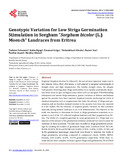| dc.contributor.author | Yohannes, Tadesse | |
| dc.contributor.author | Ngugi, Kahiu | |
| dc.contributor.author | Ariga, Emanuel | |
| dc.contributor.author | Abraha, Tesfamichael | |
| dc.contributor.author | Yao, Nasser | |
| dc.contributor.author | Asami, Pauline | |
| dc.contributor.author | Monday, Ahons | |
| dc.date.accessioned | 2017-03-31T07:28:09Z | |
| dc.date.available | 2017-03-31T07:28:09Z | |
| dc.date.issued | 2016 | |
| dc.identifier.citation | Yohannes, T. , Ngugi, K. , Ariga, E. , Abraha, T. , Yao, N. , Asami, P. and Ahonsi, M. (2016) Genotypic Variation for Low Striga Germination Stimulation in Sorghum “Sorghum bicolor (L.) Moench” Landraces from Eritrea. American Journal of Plant Sciences, 7, 2470-2482. doi: 10.4236/ajps.2016.717215. | en_US |
| dc.identifier.uri | https://www.scirp.org/journal/PaperInformation.aspx?PaperID=72787 | |
| dc.identifier.uri | http://hdl.handle.net/11295/100747 | |
| dc.description.abstract | Sorghum (Sorghum bicolour (L.) Moench), the second most important staple crop in Sub-Saharan Africa (SSA) after maize, is well adapted to marginal environments of drought stress and high temperatures. But besides drought stress, the obligate root-parasitic flowering plant Striga hermonthica is an equally economically important biotic stress in agro-ecological zones where soils are marginal. Notwithstanding widespread and intense Striga infestation, genetic variations in defence mechanisms against the parasite have been reported. Sorghum variants, producing low levels of chemical stimulants such as sorgolactones that deter the advance of Striga seed germination and are therefore deemed resistant to the parasite, have been also reported in a few studies. But the existence of sorghum genetic variation for this resistance especially among farmers’ landraces is yet to be demonstrated. The objective of this study was therefore to determine the levels of Striga germination stimulants in response to each of the 111 collected sorghum landraces and their progenies from Eritrea. The ability of a sorghum genotype to cause germination of a Striga seed as a measure of the amount of the germination stimulant produced was used to assess the resistance of these accessions. The data were recorded as Striga germination percentage by counting the number of germinated Striga seeds. Landraces EG47, EG1261, EG830, EG1076, EG54 and EG746 with 14.68%, 15.32%, 11.85%, 13.05%, 15.74% and 16.5% germination percentages respectively were found to stimulate low levels of Striga germination percentage compared to commercial checks, IS9830, SRN39, Framida, with 22.46%, 22.67%, 23.27% germination respectively. While these variants did not show complete resistance against Striga seed germination, the low level production of stimulant indicated their high level of resistance to Striga . These results implied that these accessions are likely potential sources of resistance against Striga infestation in SSA sorghum breeding programs. | en_US |
| dc.language.iso | en | en_US |
| dc.publisher | University of Nairobi | en_US |
| dc.rights | Attribution-NonCommercial-NoDerivs 3.0 United States | * |
| dc.rights.uri | http://creativecommons.org/licenses/by-nc-nd/3.0/us/ | * |
| dc.subject | Eritrea, Landrace Sorghum, Striga hermonthica , Striga Germination Stimulants, Seed, Parasitic Plants | en_US |
| dc.title | Genotypic variation for low striga germination stimulation in sorghum “sorghum bicolor (L) moench” landraces from eritrea | en_US |
| dc.type | Article | en_US |



